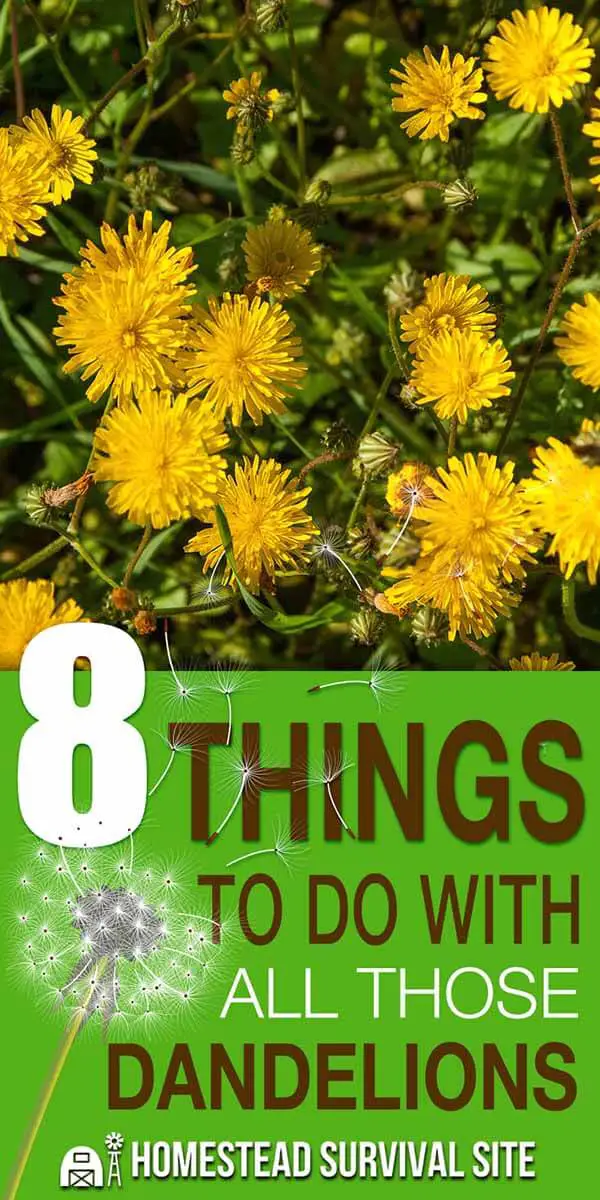Estimated reading time: 5 minutes

Disclaimer: I am not a medical doctor and nothing in this article should be taken as medical advice. Please talk to your doctor before using any of the herbs and/or remedies mentioned in this article.
I fondly remember the toddler days when my children would pick small bouquets of dandelions and lovingly present them to me. I would thank them and then place the “pretty flowers” in a small vase on the kitchen windowsill. Other than those delightful moments, however, I harbored dark thoughts about those bright yellow blooms. How dare they crop up each spring in my otherwise healthy green lawn?
Yes, the lowly dandelion is the bane of many gardeners. The persistent weeds are amazingly strong and resilient and tend to flourish anywhere they like – in driveway cracks, in raised beds, under trees, and right smack in the middle of your lawn.
However, did you know that those pesky plants have many benefits and uses? For one thing, every part of the dandelion is edible–from root to stem to flower–and it contains vitamins A, B, C, D, and K as well as iron, magnesium, calcium, potassium, and zinc.
In fact, dandelions have been used for centuries for healing purposes, and they are sold in many health food stores in tea and capsule form.
To harvest your own dandelions, it is important to make sure they haven't been exposed to dangerous pesticides, weed-killers, or other chemicals. Pick them in the morning since they can wilt in the strong afternoon sunshine.
In addition, harvest newly emerged plants, since dandelions can become bitter tasting as they age. If you are not using the roots, trim the stems an inch or more above ground level. That way, the plant will grow back for future harvesting.
Until you are ready to use them, store the dandelions in the refrigerator in a plastic container with a paper towel over them to absorb any moisture and condensation. Like other greens, dandelions will spoil after a couple of days if stored in a damp condition in a plastic bag.
Now let’s look at some of the many ways you can use dandelions as you pursue a more natural lifestyle.
Want to start a homestead but not sure how?
Click Here to get a FREE book, "How To Homestead No Matter Where You Live."
1. Dandelion Tea
Dandelion tea is used in alternative medicine, particularly as an aid for the digestive system. Drinking the tea can decrease bloating and ease kidney ailments.
Here's how to make dandelion tea:
2. Dandelion Coffee
The long taproot of the dandelion can be harvested in autumn for roasting and grinding into a chicory-flavored coffee substitute. This drink has a similar rich taste to coffee but offers the health benefits of medicinal tea.
Here's how to make dandelion coffee:
3. Natural Dye
One of the best features of dandelions is their sunshiny color. Did you know you can use that color as an alternative to chemical-based dye? You can brighten up your homespun wool and other fabrics with dandelion yellow dye. Here's how:
4. Pain Relieving Oil
You also can use dandelions to make a soothing oil to reduce muscle and joint pain. The oil is easy to make. First, fill a small mason jar with fresh dandelion blooms and then pour in olive oil, almond oil, or another base oil of your choosing until the jar is full.
Cover the jar and leave it in a warm place for two weeks to infuse before straining the oil and then decanting the oil into a sterilized jar. Store the oil in the fridge.
Check out this video for instructions:
5. Pain Relieving Salve
You also can turn the oil infusion into a healing, portable salve by blending it with beeswax. Here are the instructions:
6. Wart Remover
The sticky white resin that comes from dandelions can work as an effective and natural wart remover. Simply apply the sap directly onto warts several times per day until they disappear.
7. Dandelion Wine
Another popular use for dandelions over the centuries is as a base for a fruity, light wine. Here is a recipe that makes about one gallon of dandelion wine.
Ingredients
Want to start a homestead but not sure how?
Click Here to get a FREE book, "How To Homestead No Matter Where You Live."
- 4 cups dandelion flowers
- 6 cups boiling water
- 2 1/2 cups sugar
- 1 lemon, thinly sliced
- 1 orange, thinly sliced
Directions
- Place dandelion flowers in a large, sterilized pot. Pour boiling water on them, then cover and let them steep for a minimum of four hours and up to 24 hours.
- Strain the tea into another large pot, pressing the petals to extract more flavor. Discard the blossoms and bring the tea to a boil.
- Place the sugar in a heatproof one-gallon jar. Pour the boiling tea into the jar and stir to dissolve sugar. Add the lemon and orange slices. Cover the jar and allow the liquid to stand at room temperature for two weeks. Shake the jar to mix contents well every few days.
- Pour the wine through a fine-mesh strainer that is lined with a coffee filter into a sterilized container. Serve. Cover and store dandelion wine in the refrigerator for up to three weeks.
8. Dandelion Greens
You also can eat young dandelion greens in a salad. Be sure to harvest the plants before flowering begins for best flavor.
Cut any foliage away from the root, saving the roots to make tea, if you like. Lightly steam the leaves in a steamer basket for about 10 minutes until they are tender, thend serve.
Another option is to stir-fry chopped dandelion leaves in olive or sesame oil, along with some garlic and perhaps a sprinkling of red pepper flakes.
You can substitute dandelion leaves, which are rich in antioxidants, in most recipes that call for kale and collard greens.
Here's a video on dandelion salad preparation:
Once again, before harvesting dandelions, make sure they are not growing in an area that has been sprayed with an herbicide or a pesticide or where animals are free to roam. Good luck harvesting and feel free to put a few of the cheerful blooms in a vase on your windowsill!


Hi, I have eaten Dandelion most of my life, guess I’m a fan. But you eat what ya got.
I am surprised no-one ever mentions an excellent preparation.
Of course use clean leaves, young as possible. Fry up a few slices of bacon and crumble, save the fat. In the fat a bit of butter, flour, touch of milk and a few drops of apple cider vinegar. Lastly crumble a hard boiled egg or two.
Sorry this is an “old Person ;-)” type of recipe. Kinda by eye. But it all depends on what you have.
Enjoy and Survive On!!